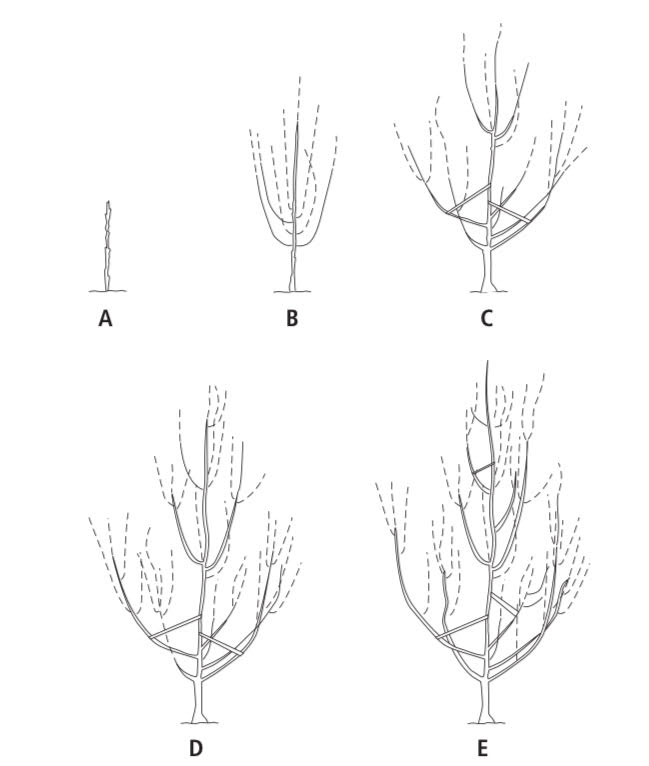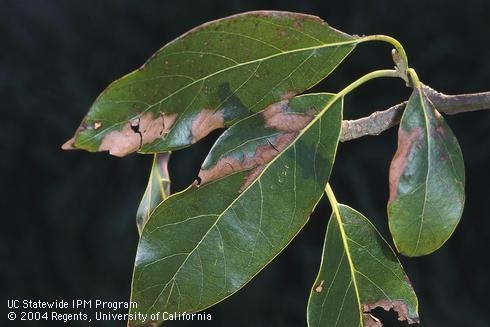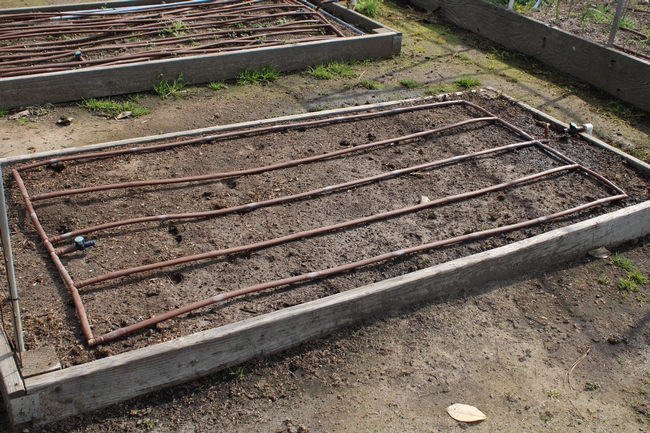- Author: Elinor Teague

It's so nice to have a lush garden again (however short the time until drought resumes) but the vigorous plant growth will cause problems this summer.
Plants and trees that have suddenly outgrown their spaces this spring will obviously need to be trimmed back, but the trimming and pruning should not be a one-time major cut back. Reducing the size of the leaf canopy by more than 25 to 30 percent during the growing season removes too much of the plants' and trees' sources of energy and can cause stunted growth. A light pruning using thinning cuts to reshape the outer canopy of only those branches that are obstructing access or that risk causing property damage would be best during the summer. Leave the removal of larger branches and branch scaffold restructuring until winter when deciduous trees are dormant.
The recent overgrowth on many plants will have shaded the soil underneath the larger canopy as well as the roots that extended to the edge of the enlarged canopy. Those roots may well die back in the hot soil. Expect to see some wilting and signs of heat stress after even moderate pruning.
The second caution on pruning overgrown plants this summer involves the risk of sunburn on newly exposed interior wood. We can expect that the Central Valley will experience several heat spikes, or long periods of high daytime temperatures (above 100 degrees) along with warm nighttime temperatures, in the next few months. Sunburn is a common problem on hedges that are pruned heavily during the summer in the Central Valley with the hedge tops showing most of the damage from the sun's rays. It's best to shear hedges lightly and frequently, every six to eight weeks, in the summer. To help reduce damage from sunburn, use a mixture of half water/half white latex paint on exposed wood, especially on citrus and other fruit and nut trees, to reflect some of the sun's harsh rays. The open center or vase-shaped pruning system on most fruit and nut trees should be maintained in the summer months.
The UC ANR publication 8057 on pruning deciduous trees has line drawings of several pruning methods and a glossary of pruning terms, which provide very basic pruning information. A long time favorite pruning guide, Orthos' ‘All About Pruning,' is once again out of print but worth searching for in used book stores for its excellent detailed descriptions, drawings and photos of the proper pruning techniques specific to many tree and bush species. DK Publishing (one of the best publishers of garden books) has “Grow Pruning and Training" ISBN 9780744026832, $12.99, which seems to be a good replacement for the Ortho guide.
- Author: Elinor Teague

The terms ‘potting soils' and ‘potting mixes' seem to be interchangeable. There is no garden-type soil in these products. They are soil-less mixes of ground redwood or other tree barks, peat moss, composts and/or humus, sand and perlite and/or vermiculite. Vermiculite retains water; perlite improves drainage and aerates the soil to allow roots to spread more easily.
Big box garden centers are the primary sources of gardening supplies and equipment for the majority of home gardeners, especially beginner home gardeners. It's worth taking a tour of a local big box garden center soils aisle to make note of the choices available and to check labels for specific information on potting soil mix contents and formulations. Master Gardeners' anecdotal information on the results of their use of preferred brands is extremely helpful as well.
The big box home improvement center closest to my home carries several nationally known brands of potting soil mixes, both organic and non-organic, for indoor plants, African violets, cacti and succulents, raised beds and container plants. Types and quality of components and the percentages of those components contained in potting soils vary widely by manufacturers; labels often provide minimal information.
Some labels on both organic and non-organic potting mixes claim that their potting soils will feed plants for 6 or 8 months, and that less watering is required. The tiny list on the very bottom of the bag (reading glasses required) provides percentages of the additional fertilizer added to the soil. There may also be mention of an added wetting agent, but the wetting agent is not always named. Wetting agents or surfactants, both synthetic and organic (e.g. yucca), help keep potting soils from drying out and help water move through the soil.
The percentages listed of added nutrients in almost all of the products is very low, 0.10 percent on average. A good quality low-nitrogen organic fertilizer will contain at least 4 percent nitrogen. The minute amounts of added chemically derived fertilizers can be easily leached out with watering. Organic potting soil mixes that contain natural ingredients like bat guano, earthworm castings or dehydrated manure may continue to provide lower-percentage nutrients for a longer period of time, but plants potted in either type of mix will require additional applications of a good quality fertilizer on a consistent basis to ensure vigorous growth and health throughout their growing seasons or lives.
Most perennial potted plants benefit from annual repotting and soil replacement since potting soil mixes often quickly lose their capacity to retain water and nutrients during our long, hot summers, with or without an added wetting agent. The time span between waterings depends mostly on the quality and composition of ingredients and the density and texture of the potting soil.
- Author: Elinor Teague

Two of the most popular subjects of companion planting on the internet are “Planting a Three Sisters Garden” and “whether planting marigolds as companion plants will repel pest insects and provide control for nematodes.”
The ‘three sisters' trio of plants (beans, corn, squash) is a great example of successful companion planting developed by Native Americans centuries before the arrival of European settlers. The plants are grown together for the benefit of all of them. The corn stalks support the bean vines as they grow; the beans fix nitrogen in the soil; the large squash leaves shade the roots. The timing of seed planting and best varieties for specific climate zones is not always provided by internet sources.
Whether or not marigolds repel pest insects and whether they control for nematodes is not clear from science-based studies, but many gardeners now are firm believers in the practice of planting marigolds as companion plants. There is (some) science-based evidence that green tilling French marigolds (Tagetes patula) into the soil the season before planting does reduce the nematode population somewhat, but not always. Marigolds do produce compounds that may (or may not) repel insects, but which insects and how the compounds work has not been fully studied.
As Master Gardeners we often need to gently correct misinformation gleaned from the internet and redirect home gardeners to research and science-based sources. Over the last decade companion planting has become increasingly popular and researchers are beginning to study the effects of companion planting in home gardens. Companion planting is an effort to encourage natural plant-derived controls for plant diseases, pest insects and weeds, thereby reducing the use of herbicides and pesticides. Some examples of the efficacy of companion planting have been verified by scientific evidence as well as anecdotal observations.
Here are a few of the more commonly recommended companion planting tips that Master Gardeners can offer with confidence:
- The planting of nitrogen-fixing plants, such as peas and beans, and cover crops, such as clovers, raises nitrogen levels in the soil. When the cover crops are tilled into the soil as green mulch, the soil texture and water retention improve.
- Planting host plants like artemisia as habitats and food sources for predatory beneficial insects like lady beetles helps reduce pest insect populations in the garden.
- Planting flower species that bloom in succession and that include all three flower types – umbellifer (dill, Queen Anne's lace), tubular (penstemon, trumpet vine) and open-faced (daisies, coreopsis) – ensures that the garden provides nectar and pollen throughout the growing season as food for pollinators, beneficial insects and hummingbirds.
- Planting taller sun-loving plants next to short ones provides shade for the shorter plants as does planting larger-leafed shorter plants between rows of taller plants. The shade discourages weed growth and helps keeps roots cooler.
Sources:
Better Together: The New Science of Companion Planting, UC Master Gardeners of San Mateo and San Francisco counties
Beneficial Insect, Insectary Plants, UC Integrated Pest Management Program
Plant a Three Sisters Garden: Corn, Beans and Squash, The Old Farmer's Almanac
- Author: Elinor Teague

Fungal problems on plants are usually short-lived here in the Central Valley. High temperatures and low humidity beginning in May quickly kill off fungal spores. We seldom see common fungal problems like powdery or downy mildews, rust or black spot after May.
Biological fungicides or biofungicides are gradually replacing a wide range of fungicides including chemically derived broad spectrum products, as well as least-toxic products such as copper and sulfur solutions, horticultural oils, neem oil and jojoba oils. Fungi are plant-specific and biofungicides have a long list of treatable fungi on many different plant species.
Biofungicides are formulated with naturally occurring living microorganisms, beneficial bacteria, that are found on plants or in the soil. Labels on biofungicides for home and garden use may not clearly indicate that the product is a biofungicide. The labels will show bacterial strains as the active ingredient. The two most common are Bacillus subtilis and Bacillus amlolyquefaciens.
The microorganisms are effective at controlling fungal pathogens in several ways: They out-compete fungus for nutrients and space, they trigger resistance in the host plant to the pathogen, they produce antibiotics or toxins that weaken or destroy the pathogen.
Biofungicides are organic products and can be as effective or even more effective in treating or controlling most of the common fungal problems in home gardens than can either broad-spectrum chemically derived or the least-toxic fungicides. They are less toxic than copper and sulfur products.
However, the use of biofungicides is not without problems. They are preventative rather than curative treatments. Great care must be taken to remove all plant debris and even soil from areas in the garden where plants have previously shown fungal problems. New transplants should be examined carefully for signs of fungal infestations and, if in doubt, the potting soil should be drenched with a biofungicide or removed and replaced with fresh, sterilized soil.
Application timing is easily thrown off by rain showers. I was unimpressed with the results of using a biofungicide last spring on Romano bean plants due to rain showers continuing well into April. Biofungicides, like other fungicides, should not be applied when rain is predicted, temperatures are above 90 degrees or on drought-stressed plants.
Because biofungicides are composed of living organisms, shelf life is reduced. Two home-and-garden-use biofungicide labels (Serenade and Monterey Complete Disease Control) do not provide use-by dates or storage temperature ranges. The UCONN IPM website does give that information for a range of biofungicides used in greenhouses and agriculture. Maximum use-by date ranges from 18 months to 3 years. Some formulations require refrigeration or have a maximum temperature. Information on whether those same restraints apply to home and garden use products was unavailable.
The same UCONN IPM article emphasizes the importance of wearing protective clothing and using caution when applying biofungicides. The two labels mentioned above are less emphatic in their recommendations.
Sources:
- CT IPM program, UCONN College of Agriculture, Health and Natural Resources, Biological Fungicides.
- UCIPM, Fungicides, Powdery Mildew on Vegetables
- UCANR, “Pests in the Urban Landscape', Biological Fungicides: Do They Work and Are They Safe?, Steven Swain, 2014, UC IPM Green Bulletin Newsletter.
- Author: Elinor Teague
As of the writing of this blog at the end of January, the Fresno/Clovis/Madera region has received only 2.79 inches of rain so far this water season, less that 25 percent of the yearly average of 11.01 inches. Unless the Central Valley receives heavy rainfall this spring, we will once again be experiencing severe drought conditions. NOAA scientists have recognized a correlation between drought periods and heat spikes. As the soil in the Valley dries out and warm dry air rises, high pressure domes form over our area, which causes temperatures to rise to extreme levels. We can anticipate that the Central Valley will also experience heat spikes along with the drought this year.
Our efforts to conserve water and also maintain the health and vigor of trees and plants in our gardens should begin in earnest this month.
There are quite a few types of irrigation devices easily available to home gardeners. Lawn sprinklers include both overhead and pop-up types. Up to 60 percent of the water applied by overhead sprinklers can be lost to evaporation, runoff and overly deep irrigation. Using pop-up or ground level sprinklers can minimize water loss somewhat. During drought periods and especially during heat spikes, irrigation of lawn grasses should be stopped or at least reduced to a bare minimum.

The amount of water and the irrigation pattern applied by emitters varies by emitter type. Choosing the right rate flow for each plant size and species and the best watering pattern is a very important part of irrigation design.
All types of irrigation systems should be on timers and those timers should be adjusted often to maintain soil moisture levels to the minimum needed to keep plants alive. When heat spikes are predicted, trees and plants should be deep irrigated before the spikes occur. Smart timers that are connected to the internet as well as local weather stations can be programmed and controlled by phone apps. Digital hose end timers can be programmed to turn on several times a day on a seven-day schedule with a rain mode option. There are simpler and cheaper hose end timer models as well. The old-school manually programmable timers as well as more advanced models that are wired to an electrical source are still available.
Sources:
California Agriculture magazine, UC Agriculture and Natural Resources

